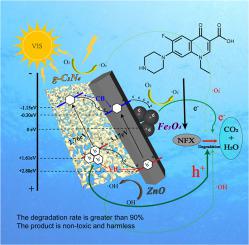Ecotoxicology and Environmental Safety ( IF 6.8 ) Pub Date : 2021-09-06 , DOI: 10.1016/j.ecoenv.2021.112742 Qingguo Chen 1 , Yan Hao 2 , Zhao Song 2 , Mei Liu 1 , Dongzhi Chen 1 , Baikang Zhu 1 , Jianmeng Chen 1 , Zhi Chen 3

|
Degradation of norfloxacin (NFX) by zinc oxide (ZnO)/g-C3N4, a magnetic sheet ZnO with g-C3N4 on its surface was studied. Through a new preparation system method, hydrothermal reaction provides a solid-layered magnetic ZnO material basis, and the simple thermal condensation method was used to transform the urea into g-C3N4 on the magnetic sheet ZnO in a uniform and orderly manner to increase the stability and photocatalytic performance of the material. Compared with previous studies, the pore volume and photocatalytic performance of the material are improved, and became more stable. By studying the degradation effect of basic and photocatalytic materials prepared in different proportions, the kinetic constant of ZGF is 0.01446 (min−1). The response surface methodology (RSM) was used to study the optimization and effect of solution pH (4−12), photocatalyst concentration (0.2–1.8 g/L), and NFX concentration (3–15 mg/L) on the degradation rate of NFX during photocatalytic degradation. The R2 value of the RSM model was 0.9656. The NFX removal rate is higher than 90% when the amount of catalyst is 1.43 g/L, the solution pH is 7.12, and the NFX concentration is less than 8.61 mg/L. After 5 cycles, the degradation rate of magnetic materials decreased to 92.8% of the first time. The capture experiment showed that the photocatalytic machine Toxicities was mainly hole action. The TOC removal rate within 2 h was 30%, a special intermediate toxicity analysis method was adopted according to the characteristics of NFX's inhibitory effect on Escherichia coli community. The toxicity of degraded NFX solution disappeared, and the possibility of non-toxic harm of by-products was verified. LC-Q-TOF method was used to detect and analyze various intermediate products converted from NFX after photocatalytic degradation, and the photocatalytic degradation pathway of NFX was proposed.
中文翻译:

新型层状结构磁性ZnO/g-C3N4优化可见光下诺氟沙星光催化降解条件及毒性评价
研究了氧化锌 (ZnO)/gC 3 N 4对诺氟沙星 (NFX) 的降解,研究了表面具有 gC 3 N 4的磁片 ZnO 。通过一种新的制备体系方法,水热反应提供了固体层状磁性ZnO材料基础,并采用简单的热缩合方法将尿素转化为gC 3 N 4ZnO 均匀有序地作用在磁片上,以提高材料的稳定性和光催化性能。与以往的研究相比,该材料的孔体积和光催化性能都有所提高,并且更加稳定。通过研究不同比例制备的碱性和光催化材料的降解效果,ZGF的动力学常数为0.01446(min -1)。响应面法 (RSM) 用于研究溶液 pH (4-12)、光催化剂浓度 (0.2-1.8 g/L) 和 NFX 浓度 (3-15 mg/L) 对降解速率的优化和影响NFX 在光催化降解过程中的作用。R 2RSM 模型的值为 0.9656。当催化剂用量为1.43 g/L、溶液pH为7.12、NFX浓度小于8.61 mg/L时,NFX去除率高于90%。5次循环后,磁性材料的降解率降至首次的92.8%。捕获实验表明光催化机的毒性主要是空穴作用。2 h内TOC去除率为30%,根据NFX对大肠杆菌抑制作用的特点,采用特殊的中毒性分析方法社区。降解后的NFX溶液毒性消失,验证了副产物无毒危害的可能性。采用LC-Q-TOF法对NFX光催化降解后转化的各种中间产物进行检测分析,提出了NFX的光催化降解途径。



























 京公网安备 11010802027423号
京公网安备 11010802027423号